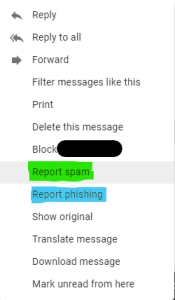| Expand | ||
|---|---|---|
| ||
|
Phishing Quiz
Can you spot when you're being phished? Take this quiz from Google and Jigsaw.
Sample Malicious Email
Here is an example of a spam malicious email message, and eight points that show you this is fake:
...
If you are ever suspicious of an email, it is better that you NOT click on any links or follow any instructions in the email. Contact the person or department the email is reportedly from via a different means, such as by phone. If you are concerned about the security of your password, navigate to the page in question yourself - not by following any links in the email - and change your password. As long as you have not clicked on any links or downloaded any attachments within a suspicious email, you can safely delete the message. (If you did follow a link or provide any sensitive information, go ahead and change your passwords. Consider running a virus scan. And depending on the scam, you may feel that some of the steps recommended in this USA Today article or this Google Support article are warranted.)
Someone shared a Google Doc with you...
...
| title | But you weren't expecting it... |
|---|
Try calling them to check.
Some Questions to Ask Yourself about A Suspicious Email
...
Although making the time to check details can seem impossible, try to take a minute to notice a few things.
...
- Does the name in the subject match the From: address?
- What does the To: address say?
- Are you listed in To: or in Bcc: (you should be in To:).
- As with most spam, check for extra typos.
Viewing a file that is shared with you should not prompt you to approve additional access. Always pay close attention to WHO is asking for WHAT access, and consider carefully whether they need it or not (this is true of the apps you install on your phone, as well!).
Do you think your account was compromised?
There are a few things you should do if you think you've been phished.
...
- Google offers a multifactor option at https://myaccount.google.com/security
- Drew offers Duo Security at drew.edu/duo
...
Steps to Take After Receiving Spam or Phishing Emails
As long as you have not clicked on any links or downloaded any attachments within a suspicious email, you can report it as spam or phishing and safely delete the message.
Why report it? Because Google can use the data to better protect everyone. Enough reports received against a particular sender will prompt Google to block that sender.
- Open the email.
- Click on the 3 dot menu to the right of the email header (next to the time the message was received)
- Choose "Report spam" (highlighted in green) or "Report phishing" (highlighted in blue)
But is it spam or a phish?
Spam is categorized as uninvited advertising - a message sent to large groups of people trying to convince them to buy a product or service.
Phishing is more targeted and more malicious. It is an attempt to garner personal information - often usernames and passwords - that can be sold and/or used to gain access to other information, systems, and/or money.
Was your account compromised?
| Excerpt Include | ||||||
|---|---|---|---|---|---|---|
|
What about spam texts?
Visit this page at the Federal Trade Commission website, https://consumer.ftc.gov/articles/how-recognize-and-report-spam-text-messages, for information about recognizing and reporting spam text messages
...
.
Additional Examples, Resources and Information
- Social Security Administration News Release about "Slam the Scam" Day on March 9, 2023
- Please visit this article for additional examples and tips for recognizing phishing emails: https://www.bettercloud.com/monitor/c-suite-phishing-attack-examples/
- This Gizmodo article does a nice job of summarizing new phishing tactics (posted 3/20/2019): https://gizmodo.com/how-phishing-scams-are-evolving-and-how-not-to-get-caug-1832618224
- This article from How-To Geek tells you what you should and should not do with a phishing email: https://www.howtogeek.com/437513/what-should-you-do-if-you-receive-a-phishing-email/
- Password Safety Guidelines
- Best Practices For Keeping Your Computer Healthy
- Avoiding Spam Phone Calls or "Vishing"
- StaySafeOnline.org article on Spam & Phishing
- SANS Cyber Security Awareness OUCH! Newsletter Archives
- USA Today article: 3 must-do steps to recover from a phishing scam
- Google Support article: I've been scammed
Reviewed 5/30/23
